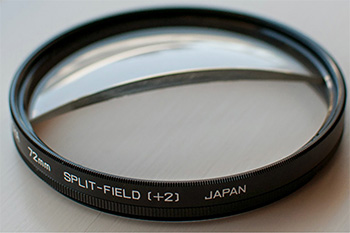Tip #688: Using a Split-Field Diopter
… for Random Weirdness
Tip #688: Using a Split-Field Diopter
Larry Jordan – LarryJordan.com
A split-field diopter is a filter that directly alters the focus within your shot.


This article, written by Anthony Najera, first appeared in PremiumBeat.com. This is an excerpt. The split-field diopter is a practical lens attachment that can add an unusual and visually exciting effect to your movie. Here’s what you need to know.
A split-field diopter is a partial lens that you attach to the front of your camera’s lens. It’s a partial lens because it only has glass covering half of the lens space. Essentially, it’s a filter that will directly alter the focus within your shot.
The split-field diopter lets you to focus on a subject (or object) positioned close to the camera on one side of the frame while also focusing on a more distant subject positioned on the other side of the frame. It allows a shot to have two planes of focus rather than one, making the foreground (captured through the diopter) and background (captured through the uncovered half of your camera’s lens) both appear equally clear.
For instance, instead of having to rely on a rack focus between a nearby subject and a distant subject, the split-field diopter keeps both near and distant focal planes sharply in focus at the same time. This can create a split-screen effect, but it happens in camera instead of in post.
Additionally, the split-field diopter can be a great alternative when you’re looking for deep depth of field. Ordinarily, to achieve a deep focus range, you’d need to stop-down the aperture quite a bit (f/16+), but this requires a ton of light and can be very difficult to do indoors. With a split-field diopter, you can create the illusion of deep focus, even with a wide aperture.
EXTRA CREDIT
The PremiumBeat article has more details and several examples of the diopter in use. The link is at the top of this tip.


Leave a Reply
Want to join the discussion?Feel free to contribute!